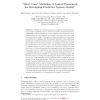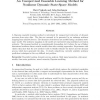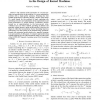901 search results - page 29 / 181 » Modelling Complex Data by Learning Which Variable to Constru... |
ICML
2004
IEEE
14 years 8 months ago
2004
IEEE
Markov networks are extensively used to model complex sequential, spatial, and relational interactions in fields as diverse as image processing, natural language analysis, and bio...
TACAS
2007
Springer
14 years 1 months ago
2007
Springer
Analysis of biological data often requires an understanding of components of pathways and/or networks and their mutual dependency relationships. Such systems are often analyzed and...
NECO
2002
13 years 7 months ago
2002
A Bayesian ensemble learning method is introduced for unsupervised extraction of dynamic processes from noisy data. The data are assumed to be generated by an unknown nonlinear ma...
IJCNN
2007
IEEE
14 years 1 months ago
2007
IEEE
Abstract— The optimal model parameters of a kernel machine are typically given by the solution of a convex optimisation problem with a single global optimum. Obtaining the best p...
NIPS
2007
13 years 8 months ago
2007
The expectation maximization (EM) algorithm is a widely used maximum likelihood estimation procedure for statistical models when the values of some of the variables in the model a...



